Abstract
Megacities are suffocated by traffic jams from streets that are often impossible to change due to the construction of cultural heritage sites or a narrow area. In the northern cities of Siberia, weather conditions exacerbate the problem, making it very difficult to initially build or improve a transport hub, and also need to look after it. The short summer brings with it repaired roads, which does not improve the traffic situation during peak hours. Transport management is constantly evolving due to economic changes in the urban environment. City-proposed upgrade of Predmostnaya ring, which is embedded in a real street model and results in the results of the model before and after the upgrade. When carrying out reconstruction, it is necessary to take at least nearby roads so as not to aggravate the already existing problematic situation. Based on the results obtained, roads are identified that also need to be expanded and a traffic light installed to redistribute the traffic load. With partial access to video monitoring, statistics are collected that are used in models. Also, by changing the operation of traffic lights, the throughput capacity increases, optimal transport flows increase.
Keywords: Optimization traffic lenght, modernization, traffic jams, megacity
Introduction
The increase in road transport is increasingly creating problems for the population. Traffic jams, ecology, stress negatively affect the productivity of cities. Transport interchanges in the central parts of cities, created decades ago, cope with the loads of cars worse every year.
To stabilize the situation, measures are being taken to improve public transport and create dedicated lanes, but it is not always possible to transfer the population to public transport. In particular, extensive construction of new micro districts is not thought out in advance, which also begin to experience transport problems after the settlement of new houses. Occasionally, sections that have been experiencing daily traffic problems for 10 years are proposed to be modified.
Problem Statement
Problem areas arise on urban roads, where a large number of cars accumulate at the same time. Shengneng et al. (2022) typically, roundabouts or intersections with traffic lights are used to prioritize traffic sequentially. In order not to stand in kilometer-long traffic jams, it is necessary to modernize the streets so that you can navigate with the influx of cars during peak hours.
Currently, one of the proposed modernizations of the urban structures on Predmostnaya of the city of Krasnoyarsk is being used. A large part of the city was studied to study and predict the impact on neighboring street paths.
Research Questions
Based on the described situation, the following questions were posed for solution:
- What additions need to be made?
- How to adjust traffic light phases?
- What problems might the proposed model face?
Purpose of the Study
For the correctness of the experiment, it is necessary to collect statistics on the number of passing cars during peak hours. Develop a model proposed by the city, upgrade it if necessary. Adjust the phases of traffic lights through the optimizer.
Research Methods
To study the problem situation, a transport model is created in the Anylogic program version higher than 7.3, where road design and optimization studies are available. The work considers:
- Approximate to the real model situation.
- Real model after optimizing traffic light phases.
- Restructured model.
- Restructured model after optimizing traffic light phases.
Model building
The section of the road from the Predmostnaya ring to Svedlovskaya, Semafornaya and 60 years of October streets is being investigated. Screenshots of this section of the road were transferred from online maps and sent to the model palette. Overlaid on the image is a road network that has occurred at the present time. Traffic lights are present at all intersections, at the traffic light ring housing during rush hours. The scale of the model is identical to that taken from the map. All roads that are suspicious of being studied are numbered and cars move between them. The developed model is shown in Figures 1,2,3,4.
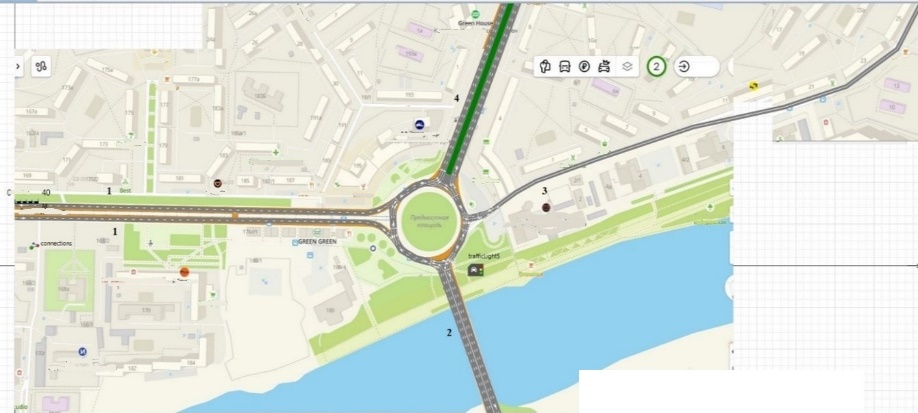
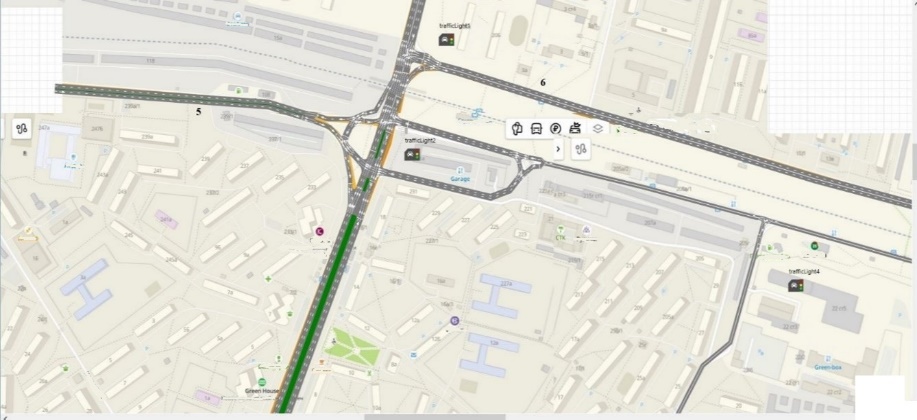
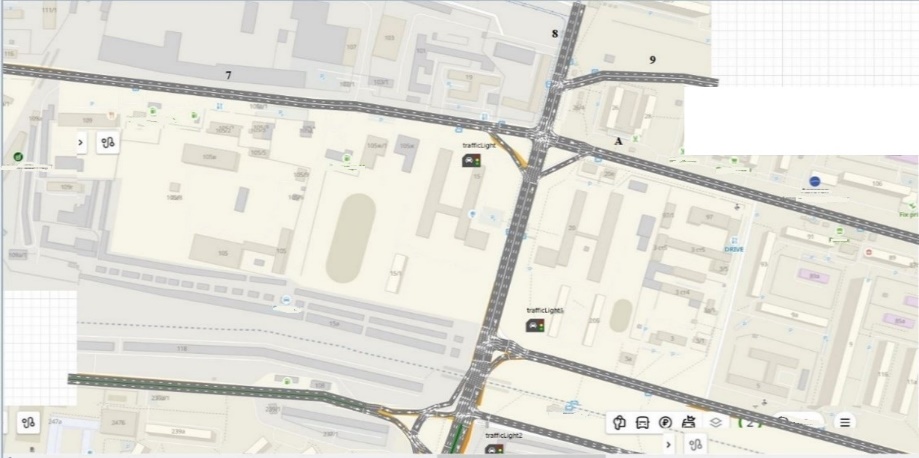
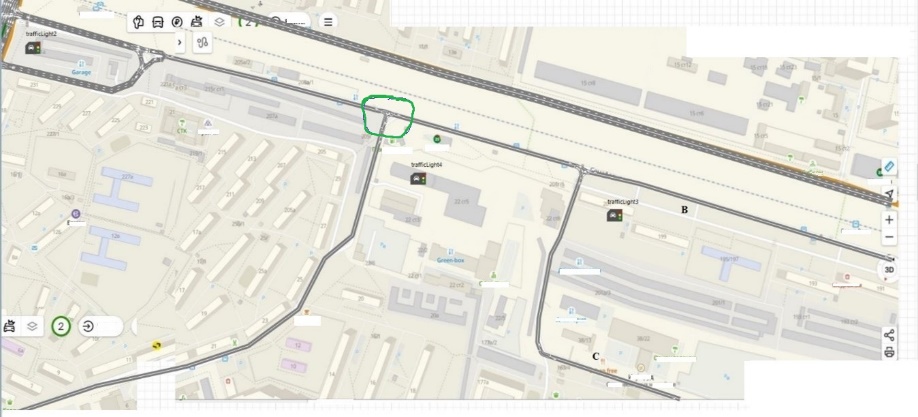
The sides numbers are signed in the figures. The model uses averages of cars appearing per hour. Ikidid et al. (2021) the remaining values are theoretical due to the lack of cameras and the possibility of collecting statistics. Road capacity information from 8 to 9 am and 5 to 7 pm is presented below (average, varies from 25 to 40 arrivals per minute):
- Side 2 has 2,000 vehicles per hour.
- Side 1 has 1900 vehicles per hour.
- 1640 vehicles pass from side 4 per hour.
- Side 5 has 1,300 cars per hour.
- Other destinations were taken up to 1500 cars per hour due to the lack of remote monitoring.
It is clear that cars move randomly and it is quite difficult to track the path of each car, so the distribution of traffic in different directions was approximately the same, where there is information about increased traffic from personal observation, the indicator increased.
Research of the behaviour of models and optimization
There is a traffic light at the roundabout that regulates traffic from side 2 and at the roundabout at the entrance to the exit to side 2 to create a temporary artificial priority for cars leaving the other side. Since it is believed that the storage on the ring is not filling up quickly, the traffic light lights up in phases - green for 120 seconds for movement from side 2 and 40 seconds for continuing movement along the ring. In my opinion, this manipulation creates even more congestion from sides 1,3,4. Stupin et al. (2022) to study the behaviour of the model, the model was run without a traffic light, with a time frame of 120/40, and optimization was carried out to maximize the throughput of cars of the entire model with the search for traffic light phase parameters. The results of the models using real phases of traffic lights are presented in Figures 5,6.


Without a traffic light on the ring, the model produces 2398 cars per hour and traffic jams are created. After optimizing other traffic lights, without taking into account the traffic light on the ring, 4098 cars per hour are obtained. With traffic light phases on the ring of 120 and 40 seconds, after optimizing other traffic lights, we get the result of 4040 cars per hour. We get a drop in throughput by 19 percent due to the included traffic light with phases 120 (from the bridge) and 40 seconds (along the ring). With the optimization of the traffic light phases on the ring, it turns out 4815 cars per hour.
Chu et al. (2015) next step, a modernized model is considered, where a second level road is created above the circle and side hinged roads for exits. The pictures highlight the places that have been changed during the modernization. Circled in black are elements that are added to the ring. Circled in red are places that need to be expanded for the correct operation of the model, because the upgraded ring has more traffic lanes and narrow roads will slow down the whole process. Green highlights the places where a traffic light will be placed to redistribute flows and improve the use of expanded roads. Also, in Figure 4, an intersection is highlighted where a traffic light needs to be added so that flows from sides B, C can get to the upgraded interchange faster. Merkuryeva and Bolshakovs (2010) all single lane roads need to be widened to a minimum of 2 to allow traffic to move faster through the system. The upgraded model is shown in Figure 7.
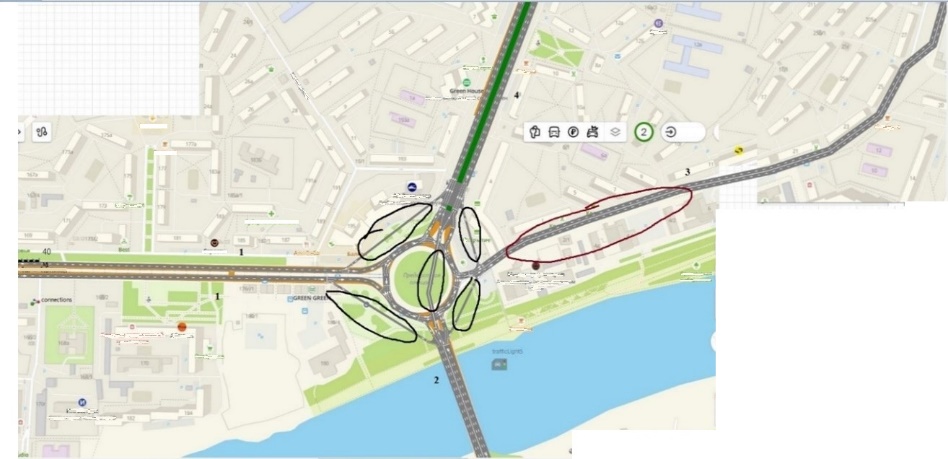
Abolghasemian et al. (2020) during the first tests of the updated model, a traffic jam began to accumulate after the exit from the updated ring and roads of cars due to incorrect phases of traffic lights, which can no longer cope with the high pressure of cars after modernization. Lu et al. (2022) this is an indicator that it is better to check in advance, Sun et al. (2018) how the modernization will affect the next intersections along the way and whether the growth of past cars will turn out or not.
The results after modernization and without optimizing the phases of traffic lights, it turned out 5120 cars per hour.
Aramesh and Ghorbanian (2020) after several runs of the model, it was revealed that on street 4, which already connects with 7, 8 and A, Chen et al. (2021) it is necessary to increase the duration of the traffic light phase so that Pop (2020) the accumulated cars can leave the system and do not impede the movement of other cars. After optimizing Kuzmin and Baginova (2021) the phases of traffic lights, the throughput of the system increased by 300 vehicles per hour. The optimization result is shown in Figure 8.
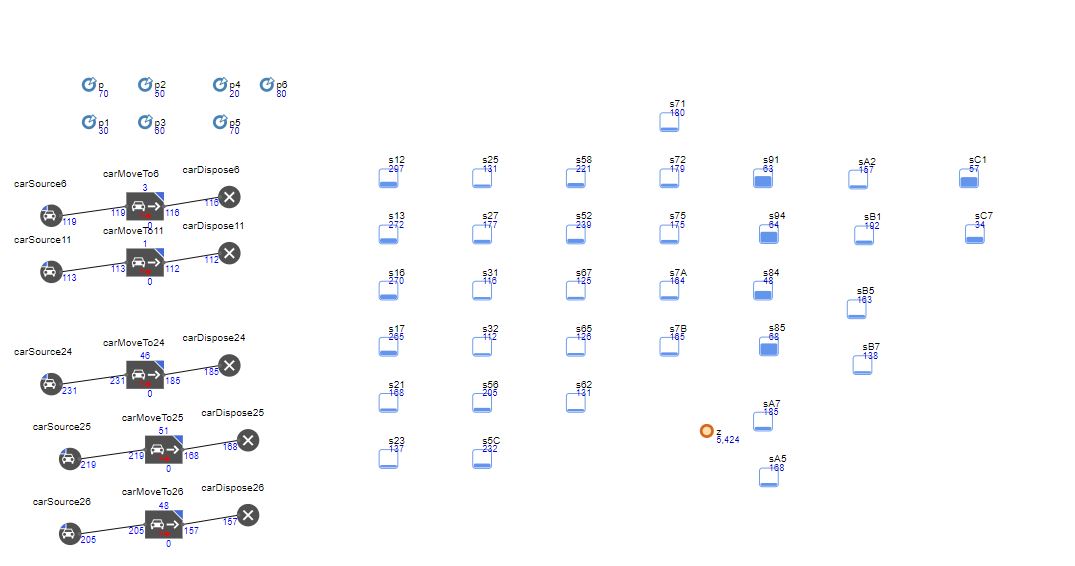
If add an additional 3 tier road from side 2 to side 1 (highlighted in yellow), then can send flows from side 2 to side 5 of the road through a small road (highlighted in black). The proposed reconstruction is shown in Figure 9.
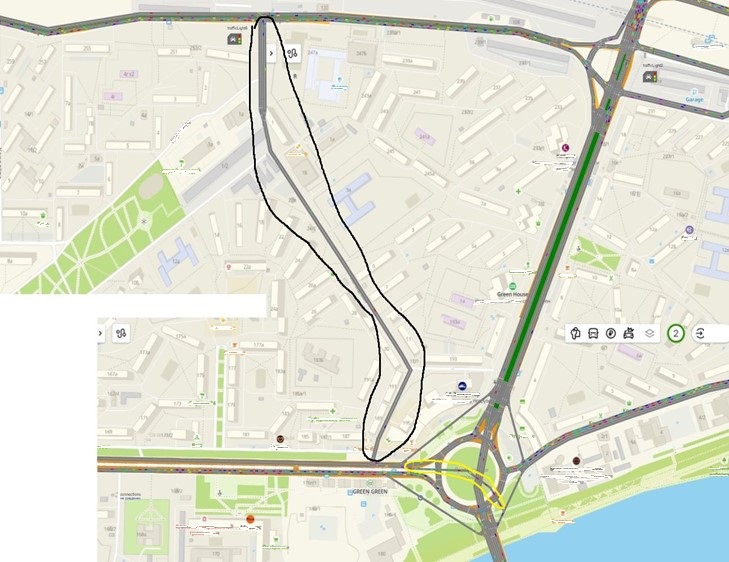
Rachih et al. (2022) after modernization, we optimize the phases of traffic lights and get the following result. The result of the model is shown in Figure 10.
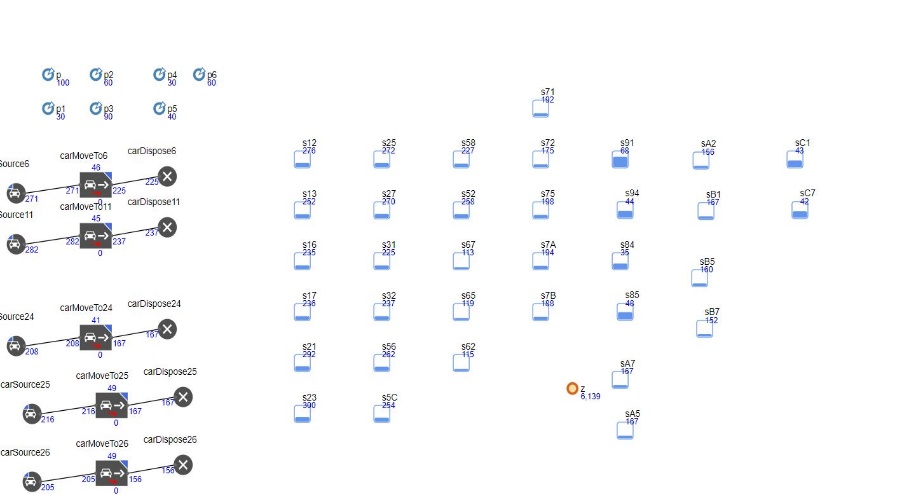
As you can see, the throughput of the system grows even more.
Findings
As a result of all the optimization work on this section, we can say that the throughput will increase to 256% and will relatively save the city from daily traffic jams. It is clear that things will remain in some places, but it will be better than what is currently available. The results of the models are presented in Table 1.
As the results show, in the model, the main indicators of the transport route do not fall, but at the same time, the indicators of long-distance roads improve. modernization of the ring and expansion of roads increase the capacity of the roads. The main increase is 250% per hour.
Conclusion
After building the updated model and optimizing it, it can be said that the proposed increase option can be implemented and has a positive trend for perceiving them to noticeable roads and intersections. Upgrading can increase throughput by several times.
The economic costs of project success are difficult to predict due to changing market conditions and the uncertainty of the year when the project requests implementation.
Acknowledgments
This work was supported by the Ministry of Science and Higher Education of the Russian Federation (Grant No.075-15-2022-1121).
References
Abolghasemian, M., Kanafi, A. G., & Daneshmandmehr, M. (2020). A two-phase simulation-based optimization of hauling system in open-pit mine. Iranian Journal of Management Studies (IJMS), 13(4), 705-732.
Aramesh, S., & Ghorbanian, A. (2020). Multi-objective Optimization for a Complex Intersection Using Design of Experiments and Simulation. Journal Européen des Systèmes Automatisés, 53(6), 791-802.
Chen, H. X., Huang, X. J., Li, H., & Zhang, H. B. (2021). Coordinated timing of multiple intersections based on Anylogic. Advances in Transportation Studies, 55, 283-290.
Chu, D., Wei, S., & Lin, Y. (2015). The application of pedestrian microscopic simulation technology in researching the influenced realm around urban rail transit station. Journal of Traffic and Transportation Engineering, 4, 242-246.
Ikidid, A., El Fazziki, A., & Sadgal, M. (2021). A Fuzzy Logic Supported Multi-Agent System For Urban Traffic And Priority Link Control. JUCS - Journal of Universal Computer Science, 27(10), 1026-1045.
Kuzmin, D., & Baginova, V. (2021). Discrete-Event Intersection Operation Model (Yasnyy Proyezd-Dezhnev street, Moscow). 14th International Scientific Conference on Precision Agriculture and Agricultural Machinery Industry, INTERAGROMASH 2021 Rostov-on-Don.
Lu, K., Tian, X., Jiang, S., Xu, J., & Wang, Y. (2022). Optimization model for regional green wave coordinated control based on ring-and-barrier structure. Journal of Intelligent Transportation Systems, 26(1), 68-80.
Merkuryeva, G., & Bolshakovs, V. (2010). Vehicle Schedule Simulation with AnyLogic. 2010 12th International Conference on Computer Modelling and Simulation.
Pop, M. D. (2020). Decision making in road traffic coordination methods: a travel time reduction perspective. In 2020 International Conference Engineering Technologies and Computer Science (EnT) (pp. 42-46). IEEE.
Rachih, H., Mhada, F. Z., & Chiheb, R. (2022). Simulation optimization of an inventory control model for a reverse logistics system. Decision Science Letters, 11(1), 43-54.
Shengneng, H., Zhen, J., Anping, Y., Kui, X. & Guoqi, H. (2022). Evaluating the Sustainable Traffic Flow Operational Features of U-turn Design with Advance Left Turn. Sustainability, 14(11), 6931.
Stupin, A., Kazakovtsev, L., & Stupina, A. (2022). Control of traffic congestion by improving the rings and optimizing the phase lengths of traffic lights with the help of anylogic. Transportation Research Procedia, 63, 1104-1113.
Sun, L., Tao, J., Li, C., Wang, S., & Tong, Z. (2018). Microscopic Simulation and Optimization of Signal Timing based on Multi-Agent: A Case Study of the Intersection in Tianjin. KSCE Journal of Civil Engineering, 22(9), 3373-3382.
Copyright information

This work is licensed under a Creative Commons Attribution-NonCommercial-NoDerivatives 4.0 International License
About this article
Publication Date
27 February 2023
Article Doi
eBook ISBN
978-1-80296-960-3
Publisher
European Publisher
Volume
1
Print ISBN (optional)
-
Edition Number
1st Edition
Pages
1-403
Subjects
Hybrid methods, modeling and optimization, complex systems, mathematical models, data mining, computational intelligence
Cite this article as:
Stupin, A., Ovchinnikova, I., Shagaeva, O., & Stasiuk, V. (2023). Testing of the Proposed Road Upgrade at the Predmostnaya Ring in Krasnoyarsk. In P. Stanimorovic, A. A. Stupina, E. Semenkin, & I. V. Kovalev (Eds.), Hybrid Methods of Modeling and Optimization in Complex Systems, vol 1. European Proceedings of Computers and Technology (pp. 357-365). European Publisher. https://doi.org/10.15405/epct.23021.44

